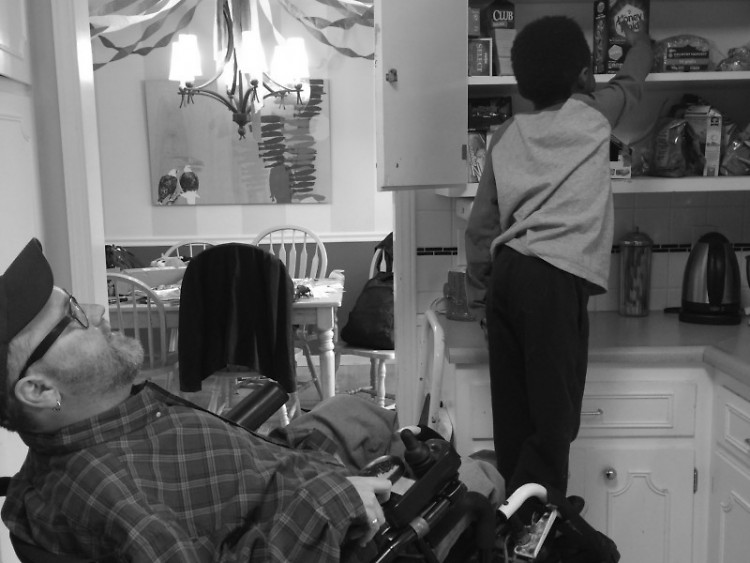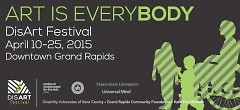It’s all about cookies.
My 6-year-old son and I are home alone, Mom is at work, and the child desperately wants a cookie. Said cookie is on the third shelf of a cabinet that neither he nor I can reach on our own. But working together, we have figured out a way to feed his craving. He steps on the footplate of my wheelchair, I tilt the wheelchair back which raises all 35 pounds of his body up in the air, and the cookie is ours. Dad becomes elevator. Kid gets cookie.
Together, we have creatively solved a problem. And in some ways, we have become artists inside our own home.
"Disability is not a brave struggle or ‘courage in the face of adversity.’ Disability is an art," says Disabled performance artist Neil Marcus. "It’s an ingenious way to live.” The sentiment is a cultural manifesto, a bellowing scream from a group of people who spend their lives being objects of emotion rather than subjects of existence. Marcus knows well that Disabled people constantly perform for able-bodied society, forced to live within damaging stereotypes meant to inspire, build up or otherwise encourage non-disabled people to feel better about themselves. I've heard it said, quietly behind the back of my wheelchair, “thank God I’m not like that.”
But instead of bending to that social ignorance, Marcus proclaims that the Disabled life is one filled with artfulness and self-expression. In other words, the things that Disabled people do to survive daily life- what we might call tactics- often come from the same place in the soul that generates creativity. Navigating a busy shopping mall with a guide dog, getting through a “typical” work day with severe depression or figuring out a way to use a wheelchair to get a cookie: all of these things smack of creative energy. All of these things are Art.
Imagine what culture might feel like if this definition of disability took off, got deep into our psyches. Normally we define disability in terms of medical language and concepts; disability is the physical or physiological reality of a body that lacks a perceived healthiness. Indeed, there is an entire medical industry that needs us to see disability as something purely medical. This industry thrives on the mythology of able-bodiedness, banking on the fact that most of us are willing to to do anything, pay anything, to “fix” circumstances which supposedly keep us from health and well-being.
Understanding disability as something other than medical does not aim to eliminate the need for medical treatment. Nor does it engage in some sort of anarchist view which aims to stay away from any institutionalization of culture. If you break your arm, you get the cast and help it mend properly. If the tumor comes back malignant, you decide what treatment you want to take. And that’s the key: our medical experiences should be dictated by us rather than a system of all-powerful doctors claiming that they know better.
Too many Disabled people spend their lives navigating the never-ending rehearsal of tests, surgeries and procedures, rather than getting to a point of personal comfort, and then saying, “okay, I’m done.” The pressure to get better is simply too strong.
Defining disability as Art pulls the Disabled person out from the shadow of constant medicalization and places them within the light of self-discovery and personal volition. But even more important, contemplating disability as an art form helps erase the stigma of living a life that falls outside of “normal.”
In just a couple of days, Grand Rapids will host the largest Disability Arts Festival ever to be produced within the United States.
On the walls of the Urban Institute for Contemporary Arts, Grand Rapids Art Museum, Federal Galleries of Kendall College of Art and Design, Calvin College 106 S. Division Gallery, 250 Monroe Street Gallery and the DisArt Hub at 50 Louis Street Northwest, visitors will view contemporary examples of the finest Disability Arts in the world. Brilliant expressions of disability style and fashion will be on display in an innovative, disability centered DisArt Fashion Show. Challenging and rarely seen films from disability culture will grace the screen during the DisArt Independent Film Festival. And audiences will enjoy a closing performance at Wealthy Theatre by over 100 local disabled performers, musicians, actors, dancers and musicians. In short, DisArt Festival 2015 will be employing recognizable forms of art in order to realign our imaginations about what it means to be disabled in the 21st century.
DisArt Festival begins this Friday, April 10 at 6 p.m. with a kickoff event at the Grand Rapids Art Museum. Everyone is welcome to hear opening statements from Mayor George Heartwell, Director Christopher Smit, President of Ferris State University David Eisler, curators Amanda Cachia Aaron Williamson and many more.
The celebration continues on Friday evening with opening receptions of the centerpiece exhibition “ Art of the Lived Experiment” at the UICA, GRAM and the Fed Galleries of Kendall College of Art and Design. Also opening that evening are the 250 Monroe Street Gallery DisArt Local exhibition, Access is a Civil Right photography exhibition at Calvin College 106 S. Division and the DisArt Hub. All of these events coincide with Art Downtown along Division Avenue.
For more detailed information about Festival events visit the website or download the full festival program.
DisArt Festival, much like ArtPrize, will hold events designed for just about any demographic in Grand Rapids. Families can experience artmaking with their kids, art lovers can stroll or roll through exhibits of paintings and photography, cinema fanatics can screen never before seen films and the style gurus can celebrate fashion in an unexpected way.
Beyond the familiar art we engage with in the calm hush of an art gallery, the dim light of an expectant movie theater or the excitement of live entertainment comes another art form that we may not be accustomed to: the art of disability itself.
Many of you have seen billboards all over town with the phrase “Art is Everybody.” Indeed, this is the theme of DisArt Festival 2015. All of us, disabled or not, have a role to play in the world of creativity.
More importantly, as we are visiting all of the festival events these next two weeks, we will enact a new phase in this extraordinary community we call home. We will be witnesses of, and participants in, an inclusive city which makes a place for everyone.
The Rapidian, a program of the 501(c)3 nonprofit Community Media Center, relies on the community’s support to help cover the cost of training reporters and publishing content.
We need your help.
If each of our readers and content creators who values this community platform help support its creation and maintenance, The Rapidian can continue to educate and facilitate a conversation around issues for years to come.
Please support The Rapidian and make a contribution today.


